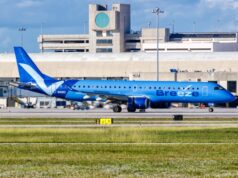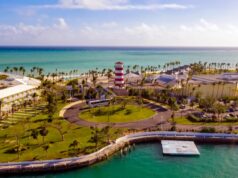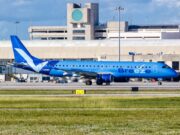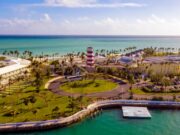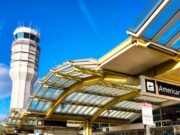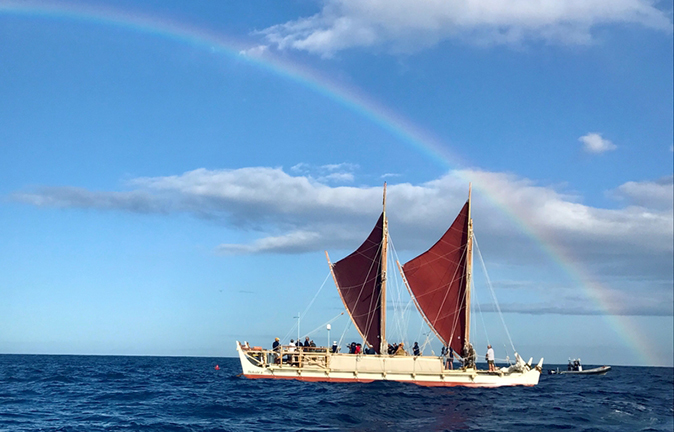
Scores of well-wishers gathered at the Marine Education & Training Center on Honolulu’s Sand Island earlier this month to bid aloha to Hōkūleʻa as her crew prepared to transport the iconic Polynesian voyaging canoe to the Pacific Northwest.
Supporters brought hoʻokupu (gifts) and draped lei on the hulls of the 64-foot canoe; they talked story with crew members and took photos from the deck. It was Hōkūleʻa’s last full day in Hawaiʻi before being loaded onto a cargo ship bound for Tacoma, Washington. She’ll journey to Yukatat, Alaska, for a “Heritage Sail” before making her way to Juneau, the launch point for a 47-month journey circumnavigating the Pacific.
This is Hōkūleʻa’s 15th major voyage in her 50-year history, and the trek is epic, not only in scope but in purpose: to ignite a movement of 10 million “plenary navigators” to pursue and lead efforts for the betterment of the planet.
“Moananuiākea: A Voyage for Earth” is an ambitious and demanding sail. From Juneau, Hōkūleʻa heads to British Columbia and Seattle, where she’ll meet sister canoe Hikianalia in August. The canoes will travel along the U.S. West Coast to Central and South America before sailing east to Aotearoa (New Zealand), Melanesia and Micronesia. The voyage is scheduled to end in Japan in the fall of 2026.
In all, the canoes will sail 43,000 nautical miles, and visit 36 countries and archipelagoes, nearly 100 indigenous territories and 345 ports. The expansive journey is an immense undertaking for the 400 crewmembers and the Polynesian Voyaging Society (PVS) – but with the future of the planet at stake, there’s an urgency to act.
“How does the earth work? You cannot protect what you don't understand,” Nainoa Thompson, master navigator and CEO of PVS, told well-wishers at the community sendoff for Hōkūlea.
Thompson recalled the Mālama Honua Worldwide Voyage (2013-2019), which took Hōkūlea and Hikianalia to more than 100 ports in 27 countries where crewmembers engaged with communities on ocean conservation and climate change issues. In sharing its message of environmental stewardship and sustainability, Hōkūlea raised awareness of the need for global cooperation and collective action to address environmental challenges.
Hōkūleʻa sailing alongside the Statue of Liberty in 2016 during the Mālama Honua Worldwide Voyage.
“We came home from the worldwide voyage and we learned so much. Infinite amounts. Every day was a story. Every day was a lesson. There were teachers across the planet that we never even knew existed,” remembered Thompson.
PVS plans to turn those lessons into action with Moananuiākea, which will tap into the power of indigenous knowledge to encourage mālama (care) and kuleana (responsibility) for the Earth.
Hawaiian Airlines understands mālama and kuleana well. Along with the pride that comes with being Hawaiʻi’s airline comes a responsibility to care for the well-being of our environment, culture and communities. The company outlines its commitments and progress in these areas in its annual Corporate Kuleana report.
When Hawaiian was approached to support Moananuiākea, the company didn’t hesitate and signed on as the official airline sponsor, donating 34 million air miles for crew travel and committing to transporting cargo associated with the voyage around the Pacific. Hawaiian was given the title of Moa’e Kū sponsor, named for the predictable, steady and reliable wind that navigators depend on.
“Crewmembers will have the arduous task of keeping Hōkūle‘a and Hikianalia on course. We will help keep you on track from a logistical perspective, transporting your crew and cargo throughout our Asia-Pacific and North America network,” said Peter Ingram, president and CEO of Hawaiian Airlines, in announcing the donation.
Hawaiian’s support of PVS goes back decades, and as the voyaging organization has broadened its mission, it has helped the airline better understand global efforts to protect natural resources. Hawaiian was the lead sponsor of the Mālama Honua voyage, whose lessons helped shape and inform our own thinking and actions.
“We’ve taken steps to be kinder to the planet and to care for this beautiful place that we are so lucky to call home,” said Ingram. “The vessels we navigate are different, but we both connect people to each other and to places that hold meaning for them.”


























































